矩阵方程AX=B, XC=D的(M,N)-反对称解
刘 巍, 王柏育
(长沙学院 数学与计算机科学系, 湖南 长沙 410022)
矩阵方程AX=B, XC=D的(M,N)-反对称解
刘巍, 王柏育*
(长沙学院 数学与计算机科学系, 湖南 长沙410022)
摘要:利用奇异值分解和广义奇异值分解,得到了矩阵方程AX=B,XC=D的(M,N)-反对称解存在的充要条件,给出了通解表达式及其最佳逼近问题的解,并提供了数值例子来说明理论结果的正确性.
关键词:(M,N)-反对称矩阵; 最佳逼近; 广义奇异值分解
0引言

定义1[1]对矩阵A=(aij)∈Rn×m和B=(bij)∈Rn×m,称A*B=(aijbij)∈Rn×m是A与B的Hadamard乘积.
定义2给定M∈Rn×p,N∈Rq×n,如果(MXN)T=-MXN,称X是(M,N)-反对称矩阵.
近些年来,文献[2-16]讨论了矩阵方程的无约束解、(反)对称解、广义(反)对称解、广义自反解、(R,S)-对称解、(R,S)-共轭解、Hermitian自反解和最小二乘解等,并得到了很好的结果.
本文研究以下问题:
AX=B,XC=D
(1)


(2)
其中,SE是问题I的解集合.
1问题Ⅰ的解
在本节中,利用矩阵的SVD分解和GSVD分解[2],给出问题I有解的充要条件以及一般解的表达式.
(3)
其中:


Σ1=diag(σ11,…,σ1r1)>0,


Σ2=diag(σ21,…,σ2r2)>0.

(4)
其中:

P2∈OR(q-r2)×(q-r2),
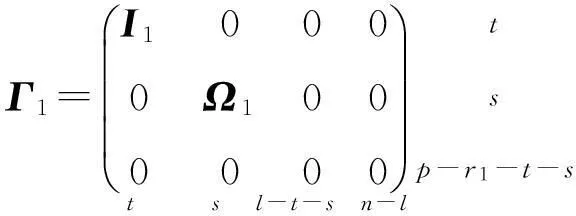
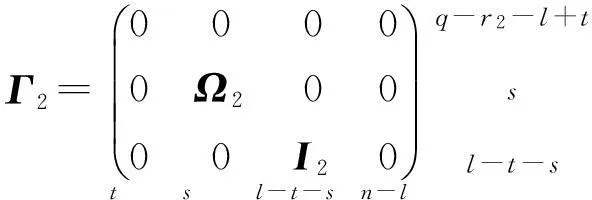
(5)



Ω1=diag(α1,…,αs)>0,
Ω2=diag(β1,…,βs)>0,
1>α1≥…≥αs>0,

引理3若矩阵F∈Rn×n,G0∈SRn×n满足
G0=F+FT, 则:
其中,G∈ASRn×n.

AA+B=B,DC+C=D,BC=AD
(6)
并且其一般解的表达式为:
(7)
其中,X22是任意的(p-r1)×(q-r2)阶实矩阵,V12、U22如引理1中所定义.

M0=M(A+B+(I-A+A)DC+)N,
矩阵H的分块如下
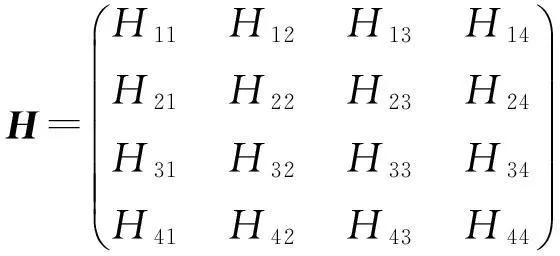
其中,Q如引理2中所定义,Hii(i=1,2,3,4)是对称矩阵.则问题Ⅰ的解集SE非空的充要条件是:
(ⅰ)AA+B=B,DC+C=D,BC=AD.
(ⅱ)H11=0,H33=0,Hi4=0,H4i=0,
1≤i≤4.
当问题Ⅰ有解时,其一般解的表达式为:
X=A+B+(I-A+A)DC++

(8)
其中:




V12、U22、P1、P2、Ω1、Ω2如引理1和引理2中所定义.

由(MXN)T=-MXN,有:

由引理2可得:
(9)

(10)
将式(5)和式(10)代入式(9),得:
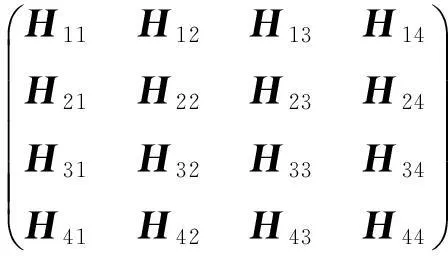
所以:
H11=0,H33=0,Hi4=0,H4i=0,1≤i≤4
(11)
(12)
(13)
式(11)即条件(ⅱ).

2问题Ⅱ的解
注意到问题Ⅰ的解集是一个闭凸集.因此,问题Ⅱ存在唯一解.先给出以下引理.

(14)

证明:设K=(kij)∈ASRn×n,L=(lij)∈Rn×n,则:


且F(K)是连续可微函数,根据函数在某点处取极小值的必要条件,可得:


定理2给定矩阵X*∈Rp×q、M∈Rn×p、
D∈Rp×s,令
的分块如下:
(15)
(16)
其中:
(17)

V12、U22、P1、P2、Ω1、Ω2如引理1和引理2中所定义.

‖X-X*‖2=

min
(18)
对S作形如式(15)的分块,则式(18)等价于


(19)
3数值例子
在本节中,给出相应的数值例子,说明所得理论结果的正确性.
例1考虑矩阵方程AX=B,XC=D,其中
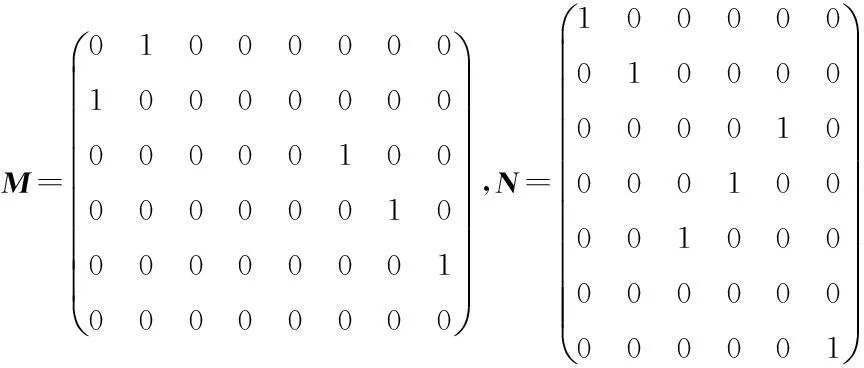
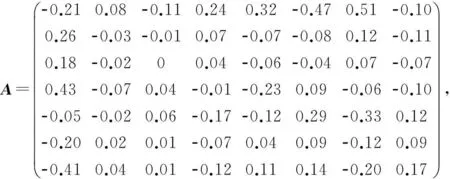
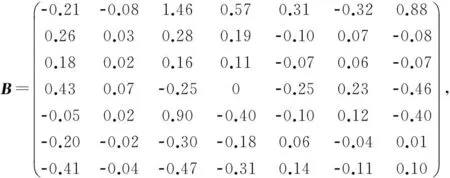
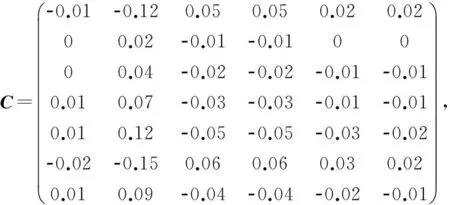
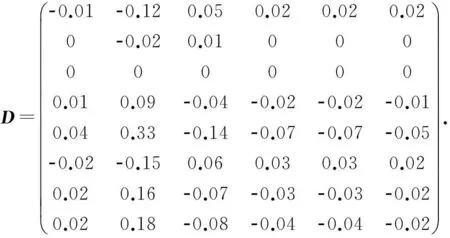
经验证,满足定理1的条件,在式(8)中,取可任意取值的矩阵均为零矩阵,可得问题I的一个解为:
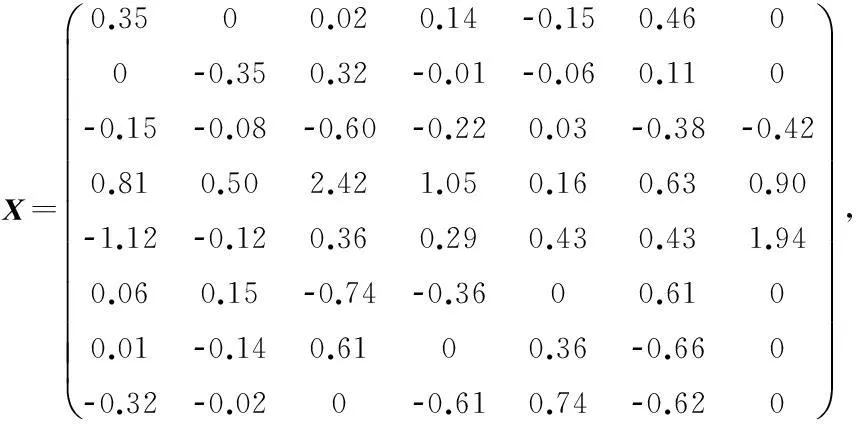
且有:
‖AX-B‖=9×10-16,‖XC-D‖=6×10-17,
‖(MXN)T+MXN‖=5×10-15
给定
根据式(16),可得问题Ⅱ的解为:
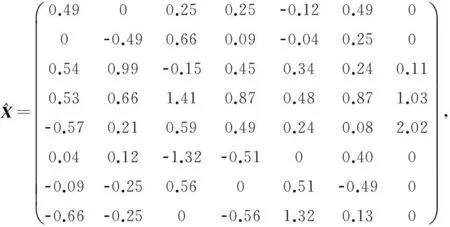
且有:


参考文献
[1]R.A.Horn,C.R.Johnson.矩阵分析(英文版)[M].北京:人民邮电出版社,2005.
[2]K.W.E.Chu.Singularvalueandgeneralizedsingularvaluedecompositionandthesolutionoflinearmatrixequations[J].LinearAlgebraAppl.,1987,88-89:83-98.
[3]S.K.Mitra.ApairofsimultaneouslinearmatrixequationsA1XB1=C1,A2XB2=C2andamatrixprogrammingproblem[J].LinearAlgebraAppl.,1990,131:107-123.
[4]S.K.Mitra.ThematrixequationsAX=C,XB=D[J].LinearAlgebraAppl.,1984,59:171-181.
[5]A.Navarra,P.L.Odell,D.M.Yong.ArepresentationofthegeneralcommonsolutiontothematrixequationsA1XB1=C1,A2XB2withapplications[J].ComputersandMathematicswithApplications,2001,41(7-8):929-935.
[6]W.F.Trench.Inverseeigenproblemsandassociatedapproximationproblemsformatriceswithgeneralizedsymmetryorskewsymmetry[J].LinearAlgebraAppl.,2004,380:199-211.
[7]X.Y.Peng,X.Y.Hu,L.Zhang.AniterativemethodforsymmetricsolutionsandoptimalapproximationsolutionofthesystemofmatrixequationsA1XB1=C1,A2XB2=C2[J].AppliedMathematicsandComputation,2006,183(2):1 127-1 137.
[8]F.L.Li,X.Y.Hu,L.Zhang.Thegeneralizedreflexivesolutionforaclassofmatrixequations(AX=B,XC=D)[J].ActaMathematicaScientia,2008,28B(1):185-193.
[9]S.F.Yuan,A.P.Liao,Y.Lei,LeastsquaresHermitiansolutionofthematrixequation(AXB,CXD)=(E,F)withtheleastnormovertheskewfieldofquaternions[J].Math.Comput.Modelling,2008,48(1-2):91-100.
[10]Y.Y.Qiu,A.D.Wang.LeastsquaressolutionstotheequationsAX=B,XC=Dwithsomeconstraints[J].AppliedMathematicsandComputation,2008,204(2):872-880.
[11]Y.T.Li,W.J.Wu.Symmetricandskew-antisymmetricsolutionstosystemsofrealquaternionmatrixequations[J].ComputersandMathematicswithApplications,2008,55(6):1 142-1 147.
[12]M.Dehghan,M.Hajarian.Matrixequationsover(R,S)-symmetricand(R,S)-skewsymmetricmatrices[J].ComputersandMathematicswithApplications,2010,59:3 583-3 594.
[13]H.X.Chang,Q.W.Wang,G.J.Song.(R,S)-conjugatesolutiontoapairoflinearmatrixequations[J].AppliedMathematicsandComputation,2010,217(1):73-82.
[14]Y.X.Yuan.Least-squaressolutionstothematrixequationsAX=BandXC=D[J].AppliedMathematicsandComputation,2010,216(10):3 120-3 125.
[15]F.X.Zhang,Y.Li,J.L.Zhao.CommonHermitianleastsquaressolutionsofmatrixequationsA1XA1*=B1andA2XA2*=B2subjecttoinequalityrestrictions[J].ComputersandMathematicswithApplications,2011,62(6):2 424-2 433.
[16]S.Zhou,S.T.Yang.TheHermitianreflexivesolutionsandtheanti-Hermitianreflexivesolutionsforaclassofmatrixequations(AX=B,XC=D)[J].EnergyProcedia,2012,17:1 591-1 597.
【责任编辑:晏如松】
The (M,N)-antisymmetric solutions of the matrix equations AX=B,XC=D
LIU Wei, WANG Bai-yu*
(Department of Mathematics and Computer Science, Changsha University, Changsha 410022, China)
Abstract:In this paper,based on the singular value decomposition (SVD) of a matrix and the generalized singular value decomposition (GSVD) of a matrix pair,we establish the solvability conditions of matrix equations AX=B,XC=D for (M,N)-antisymmetric matrices,give the expressions of general solutions and the solution of corresponding optimal approximation problem,and give a numerical example to verify the correctness of the theoretical results.
Key words:(M,N)-antisymmetric matrix; optimal approximation; generalized singular value decomposition
中图分类号:O241.6
文献标志码:A
文章编号:1000-5811(2016)03-0175-05
作者简介:刘巍(1982-),男,辽宁建平人,讲师,硕士,研究方向:数值代数通讯作者:王柏育(1981-),女,辽宁建平人,讲师,博士,研究方向:数值代数、偏微分方程,wangbaiyumath@163.com
基金项目:湖南省教育厅科研计划项目(15C0120)
收稿日期:2016-01-13

